|
|
|
|
The Jewish Holidays |
|
|
||||||||||||||||||||||||||||||||||||||||
|
The
feasts and holidays are part of the larger mosaic of Jewish time that
expresses the corporate life cycle of Jews all of the world.
|
|
The Jewish Day |
|
Since the Jewish day (yom) begins at sundown, you must remember that a Jewish holiday actually begins on the night before the day
listed in a Jewish calendar. For example, Yom HaShoah (Holocaust
Memorial Day) occurs on Nisan 27, which actually begins after sundown,
Nisan 26:
|
|
|
|
In the example above, Yom HaShoah
is observed both on Thursday the 5th (after sundown) and Friday the 6th
(during daylight hours).
Note that if a Jewish holiday were to occur on a Sabbath, it would be moved to the previous Thursday on the calendar. For example, if Nisan 27 happened to begin on Friday at sundown, it would be moved to Nisan 26. Accessing a current Jewish calendar is essential to observing the mo'edim! |
|
Weekly Mo'edim |
|
The Jewish week (shavu'a) begins on Sunday and ends on Saturday (Shabbat). The
Jewish sages have argued that Shabbat is the most important of the
mo'edim, since it is explicitly commanded to be observed in the Aseret HaDiberot (Ten Commandments).
|
|
|
|
Monthly Mo'edim |
|
The Hebrew calendar is a lunar one, and Rosh Chodesh
("Head of the Month") symbolizes the renewal of the new moon (month),
when the moon appears as a sliver in the sky. Rosh Chodesh is marked by
special liturgy.
|
|
|
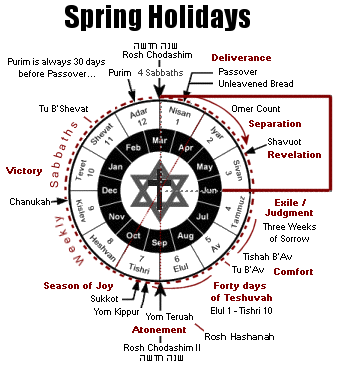 |
|
The spring feasts clearly reveal the first coming of Yeshua our Mashiach:
|
|
Summer Mo'edim |
|
In the summer there occurs a three
week period of mourning that begins with the Fast of Tammuz and ends
with Tishah B'Av (during July/August). However, after this somber time,
the romantic day of Tu B'Av, the 15th of Av occurs. Originally a
post-biblical day of joy, it served as a matchmaking day for unmarried
women in the second Temple period (before the fall of Jerusalem in 70
C.E.).
|
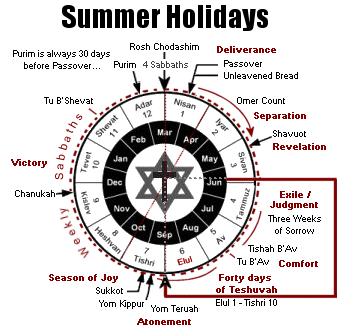 |
||||||||||
|
The summer holidays help us prepare for the second coming of the Messiah:
|
||||||||||
|
Fall Mo'edim |
||||||||||
|
The Jewish civil year begins
in the fall (though the Biblical year begins in spring). Preparations
for the fall holidays begin with a thirty day period of repentance
during the entire month of Elul. The following ten days begin with the
Feast of Trumpets (Rosh Hashanah, on Tishri 1) and end with the Day of Atonement (Yom Kippur, on Tishri 10). These first ten days of the new year are called the "Ten Days of Awe" (i.e., aseret ye'mei teshuvah: עֲשֶׁרֶת יְמֵי תְּשׁוּבָה).
|
||||||||||
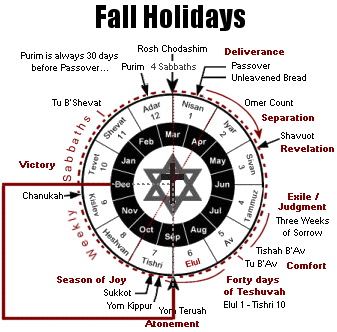 |
||||||||||
|
The Fall Feasts reveal the rapture of the kellat Mashiach (Bride
of Messiah), the second coming of the Savior, the national conversion
and atonement of Israel, God's original-covenant people, and -
especially regarding Sukkot - the final restoration of the earth in the olam habah (world to come):
|
||||||||||
|
Winter Mo'edim |
||||||||||
|
The winter holidays remember
special times when God acted on behalf of His people so that they would
triumph over their enemies, and therefore they prophetically picture the
final victory to come in olam ha-bah, the world to come.
|
||||||||||
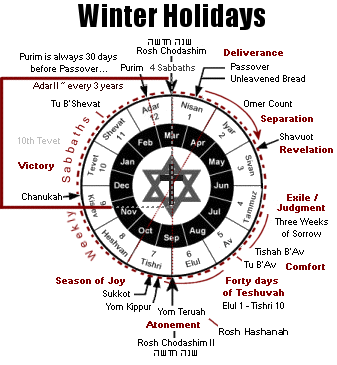 |
||||||||||
|
The winter holidays help us antcipate the final victory to come:
|
||||||||||
|
National Holidays of Israel |
||||||||||
|
Since the creation of the State of
Israel in 1948, the Chief Rabbinate of Israel has established four new
Jewish holidays (three of which occur in the month of Iyyar (Apr/May):
|
|
Fast Days (Tzomim) |
|||||||||||
|
In addition to Yom Kippur, The Talmud (Tractate Rosh Hashana 18b)
discusses four fast days (based on Zechariah 8:19) that commemorate the
destruction of the First and Second Temples and the exile of the Jewish
People from their homeland. In addition, two other fast days are
mentioned in the Rabbinical literature, yielding a total of six tzomot
(seven if Yom Kippur is included).
|
|||||||||||
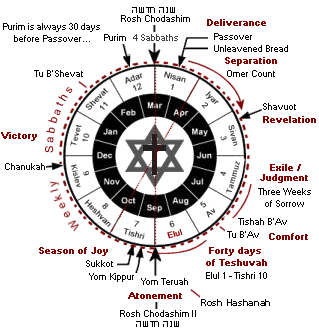 |
|||||||||||
|
|
|||||||||||

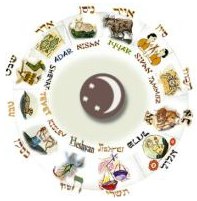




No comments:
Post a Comment